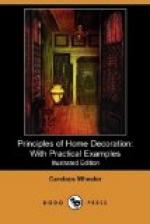In a hall which has plenty of light, but no sun, red is an effective and natural colour, copper-coloured leather paper, cushions and rugs or carpets of varying shades of red, and transparent curtains of the same tint give an effect of warmth and vitality. Red is truly a delightful colour to deal with in shadowed interiors, its sensitiveness to light, changing from colour-tinted darkness to palpitating ruby, and even to flame colour, on the slightest invitation of day-or lamp-light, makes it like a living presence. It is especially valuable at the entrance of the home, where it seems to meet one with almost a human welcome.
If we can succeed in making what would be a cold and unattractive entrance hospitable and cordial by liberal use of warm and strong colour, by reversing the effort we can just as easily modify the effect of glaring, or overpowering, sunlight.
Suppose the entrance-hall of the house to be upon the sunny side of the street, where in addition to the natural effect of full rays of the sun there are also the reflections from innumerable other house-fronts and house-windows.
In this case we must simulate shadow and mystery, and this can be done by the colour-tones of blues and greens. I use these in the plural because the shadows of both are innumerable, and because all, except perhaps turquoise and apple-green, are natural shadow-tints. Green and blue can be used together or separately, according to the skill and what is called the “colour-sense” with which they are applied.
To use them together requires not only observation of colour-occurrences in nature but sensitiveness to the more subtle out-of-door effects, resulting from intermingling of shadows and reflection of lights. Well done, it is one of the most beautiful and satisfactory of achievements, but it may easily be bad by reason of sharp contrasts, or unmodified juxtaposition.
But a room where blue in all its shades from dark to light alone predominates, or a room where only green is used, bright and gray tones in contrast and variation is within the reach of most colour-loving mortals, and as both of these tints are companionable with oak and gold, and to be found in nearly all decoration materials, it is easy to arrange a refined and beautiful effect in either colour.
It will require little reflection to show that a hall skilfully treated with green or blue tints would modify the colour of sunlight, without giving a sense of discord. It would be like passing only from sunlight to grateful shadow, and this because in all art the actual representation shadow-colour would be blue or green. The shadow of a tree falling upon snow on a sunny winter day is blue. The shadow of a sunheated rock in summer is green, and the success of either of these schemes of decoration would be because of adherence to an actual principle of colour, or a knowledge of the peculiar qualities of certain colours and their proper use. It would be an intelligent application of the medicinal or healing qualities of colour to the constitution of the house, as skilful physicians use medicines to overcome constitutional defects or difficulties in man.




